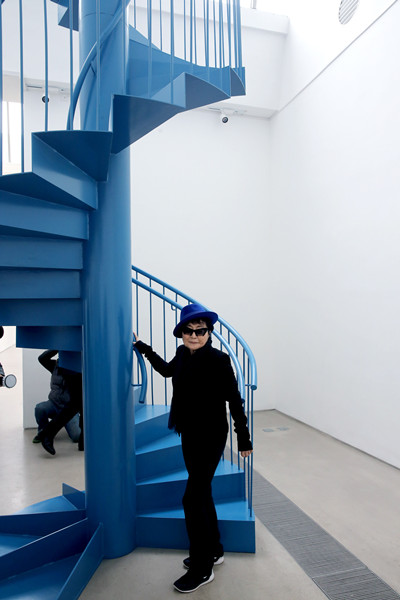
Yoko Ono poses with her work, To See the Sky, at her solo show in Beijing. [Photo by Jiang Dong/China Daily]
The 82-year-old conceptual artist and singer Yoko Ono was in Beijing late last week for her exhibition Golden Ladders, which is being held at a Faurschou Foundation gallery in the city's 798 art district.
In her signature black clothes, complete with a pair of dark sunglasses and a hat tilted to the right side of her head, the Japanese-born widow of British pop legend John Lennon reminded her fans that she was still full of energy.
On Nov 16, Ono produced an "action painting" and engaged in a conversation with Chinese contemporary artist Xu Bing at the Central Academy of Fine Arts. She calligraphed 10 Chinese characters on a board that included messages such as "the world's people unite" and "blessings".
She also performed her famous scream session that she usually describes as "the voice of a woman", but which has annoyed her critics in the past.
In addition, she "roared" at a media conference in Beijing a few days ago.
Xu says Ono's screaming at the academy was "a pretty feminist cry" and in comparison, "male voices don't sound strong enough".
During her onstage discussion with Xu, Ono seemed to talk more on feminism than her art. She said "I love you" to her audience of mostly students from time to time. They responded with cheers and whistles.
In a catalogue for the Beijing show, Ono wrote: "Please don't stop me being the way I am. I don't want to be old and sick like many others of my age.
"Let me be free! Let me be me! ... Love me plenty for what I am!"
The same auditorium had gone crazy during David Hockney's speech in April, when the English painter was in Beijing for an exhibition at Pace gallery.
Jens Faurschou, the Danish owner of the Faurschou Foundation, says Ono's ongoing exhibition in Beijing is a result of a breakfast meeting with Emma Zhang, the deputy director of Faurschou Foundation Beijing, in Berlin a few years ago.
It was Women's Day, and they came across a newspaper story that mentioned Ono as one of the women making a difference to society.
Zhang suggested they hold an exhibition in Beijing solely dedicated to Ono's works. Soon after their meeting, they ran into Jon Hendricks, who is an artist, curator and a friend of Faurschou.
But what stunned Faurschou and Zhang on the street that morning was seeing Ono with Hendricks.
"This exhibition was meant to be," Faurschou says.
Golden Ladders is Ono's second exclusive exhibition of the year, following Yoko Ono: One Woman Show, 1960-71 at the Museum of Modern Art in New York from May to September.
In Beijing, where she is more associated with Lennon than her own artistic career, Ono's exhibition reinforces her identity as an independent female artist through a display of nine works, some re-created versions of her previous pieces, inside and outside the gallery.
Xu, who first met Ono at Venice Biennale in 1993, says Ono's works stress her way of expression not in a violent, rebellious manner, but rather she speaks out her views on the world through the imagery of the sky and human mind.
Two entirely new works on show will help people understand how Ono perceives emancipation and regeneration.
Golden Ladders, an installation Ono specially created for the Beijing show, includes seven ladders of different dimensions, each plated with 24k gold foil.
Three of the ladders were collected from northern and southern China. They are old and have been extensively used.
To See the Sky, a 6.5-meter-high spiral staircase, was first exhibited at Ono's MoMa show in New York in the summer.
In the Beijing show, it lets viewers climb up to the top to find a ceiling window, showing them a Bauhaus structure. As one climbs, the staircase feels shaky, but on reaching the top, one could see more architecture, less of the sky.
Ladders are a recurring theme in Ono's art. She refers to people's existence and efforts to reach the sky-the epitome of freedom, as well as the origin and the end of all things, according to her.
"Ono invites people to participate in her art world that is full of honesty, female strength and has a Utopian outlook on life," Zhang says.
Ono arrived in Beijing on Nov 13, the evening of which terrorists attacked Paris killing nearly 130 people and injuring hundreds of others.
"Please be patient," Ono said in a message of love and peace to the world.
Planted outside the Faurschou Foundation gallery in Beijing and a neighboring square is her Wish Tree recreation.
The work was first installed in Los Angeles in 1996, with Ono wishing for world peace. Since then, "the tree" has traveled around the world gathering more than 1 million wish tags. The wish tags were sent to Imagine Peace Tower, Ono's another installation in Iceland.
Ono says she doesn't read the wishes people send because they're meant to be "secrets between the sky and people".
Asked what if there were some people also wishing that the world is destroyed.
"I said, there are also so many beautiful and powerful wishes and the bad wish will bang and change into a good one. I don't mind it."





